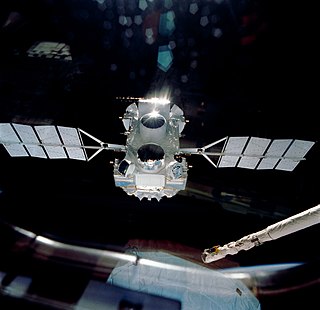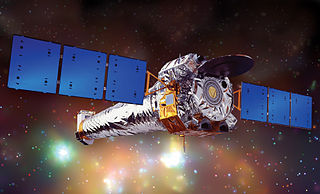
Pioneer P-31 was intended to be a lunar orbiter probe, but the mission failed shortly after launch. The objectives were to place a highly instrumented probe in lunar orbit, to investigate the environment between the Earth and Moon, and to develop technology for controlling and maneuvering spacecraft from Earth. It was equipped to take images of the lunar surface with a television-like system, estimate the Moon's mass and topography of the poles, record the distribution and velocity of micrometeorites, and study radiation, magnetic fields, and low frequency electromagnetic waves in space. A midcourse propulsion system and injection rocket would have been the first United States self-contained propulsion system capable of operation many months after launch at great distances from Earth and the first U.S. tests of maneuvering a satellite in space.

The Brazilian Space Agency is the civilian authority in Brazil responsible for the country's space program. It operates a spaceport at Alcântara, and a rocket launch site at Barreira do Inferno. It is the largest and most prominent space agency in Latin America.

The Compton Gamma Ray Observatory (CGRO) was a space observatory detecting photons with energies from 20 keV to 30 GeV, in Earth orbit from 1991 to 2000. The observatory featured four main telescopes in one spacecraft, covering X-rays and gamma rays, including various specialized sub-instruments and detectors. Following 14 years of effort, the observatory was launched from Space Shuttle Atlantis during STS-37 on April 5, 1991, and operated until its deorbit on June 4, 2000. It was deployed in low Earth orbit at 450 km (280 mi) to avoid the Van Allen radiation belt. It was the heaviest astrophysical payload ever flown at that time at 16,300 kilograms (35,900 lb).
SCISAT-1 is a Canadian satellite designed to make observations of the Earth's atmosphere. Its main instruments are an optical Fourier transform infrared spectrometer, the ACE-FTS Instrument, and an ultraviolet spectrophotometer, MAESTRO. These devices record spectra of the Sun, as sunlight passes through the Earth's atmosphere, making analyses of the chemical elements of the atmosphere possible.

The INTErnational Gamma-Ray Astrophysics Laboratory (INTEGRAL) is a space telescope for observing gamma rays of energies up to 8 MeV. It was launched by the European Space Agency (ESA) into Earth orbit in 2002, and is designed to provide imaging and spectroscopy of cosmic sources. In the MeV energy range, it is the most sensitive gamma ray observatory in space. It is sensitive to higher energy photons than X-ray instruments such as NuSTAR, the Neil Gehrels Swift Observatory, XMM-Newton, and lower than other gamma-ray instruments such Fermi and HESS.
The Low Energy Gamma-Ray Imager (LEGRI) was a payload for the first mission of the Spanish MINISAT platform, and active from 1997 to 2002. The objective of LEGRI was to demonstrate the viability of HgI2 detectors for space astronomy, providing imaging and spectroscopical capabilities in the 10-100 KeV range.

The National Institute for Aerospace Technology "Esteban Terradas" is an autonomous agency of the Spanish public administration dependent on the Secretariat of State for Defence (SEDEF). It is responsible for the aerospace, aeronautics, hydrodynamics, and defense and security technologies research.

GSAT-2 was an experimental communication satellite built by the Indian Space Research Organisation (ISRO) and launched on one of the first GSLVs. The satellite was positioned at 48 deg east longitude in the geo-stationary orbit.

An X-ray telescope (XRT) is a telescope that is designed to observe remote objects in the X-ray spectrum. X-rays are absorbed by the Earth's atmosphere, so instruments to detect X-rays must be taken to high altitude by balloons, sounding rockets, and satellites.

The Extreme Ultraviolet Explorer was a NASA space telescope for ultraviolet astronomy. EUVE was a part of NASA's Explorer spacecraft series. Launched on 7 June 1992. With instruments for ultraviolet (UV) radiation between wavelengths of 7 and 76 nm, the EUVE was the first satellite mission especially for the short-wave ultraviolet range. The satellite compiled an all-sky survey of 801 astronomical targets before being decommissioned on 31 January 2001.

The Nanosat-1B Spanish satellite, designed, developed and operated by the Instituto Nacional de Técnica Aeroespacial (INTA), is a nanosatellite which weighs 22 kg. Its main mission is the communication between remote sites like the Antarctic, the Hespérides warship and Spain. The Nanosat-1B has fourteen sides, all of them covered by solar cells but the bottom one where the following antennas are installed: a medium gain Ultra high frequency (UHF) four wire antenna and two patch antennas. On the top side there are four UHF monopoles. The solar sensors and the Vectorsol experiment are located in the middle tray, being all the other equipment and experiments located inside the satellite.
The EELV Secondary Payload Adapter (ESPA) is an adapter for launching secondary payloads on orbital launch vehicles.

Capricornio was a Spanish satellite launch vehicle developed by the Instituto Nacional de Técnica Aeroespacial (INTA) in the 1990s. It was intended to be Spain's first launcher.

INTASAT was the first satellite of Spain. It was designed by Spain's National Institute of Aerospace Technology (INTA).

Eu:CROPIS was a life science satellite developed by the German Aerospace Center (DLR) and intended to investigate the possibility of growing plants in different levels of gravity, such as that of the Moon and Mars, as a sustainable food source using human urine for moisture and as the source of fixed nitrogen.

The Nanosat 01, sometimes written as NanoSat-1 or NanoSat 01, was an artificial satellite developed by the Spanish Instituto Nacional de Técnica Aeroespacial (INTA) and launched 18 December 2004. Considered a nano satellite for its weight of less than 20 kg, its main mission was forwarding communications between far reaching points of the Earth such as Juan Carlos I Antarctic Base from mainland Spain. This was possible due to its polar orbit and altitude of 650 km above sea level. During an operational run the data obtained in the Antarctic would be uploaded to the satellite during its fly by and then, downloaded in Spain when satellite reached the Iberian Peninsula.
The INTA-100 vehicle was a small 2-stage meteorological sounding rocket designed and developed between the 1980s and the 1990s by the Instituto Nacional de Técnica Aeroespacial (INTA). The final design was entirely produced in Spain to be used by the Instituto Nacional de Meteorología in conducting experiments on the atmosphere.

OPTOS was a Spanish nanosatellite designed and developed by INTA with support from the European Cooperation for Space Standardization (ECSS) as a low-cost technology demonstrator. It was launched in 2013 and had a service life of three years.
The Lume-1 is a Spanish nanosatellite developed for educational and scientific purposes by the University of Vigo in cooperation with Alén Space, the University of Porto and the French National Centre of Scientific Research. The satellite is part of the Fire-RS program in order to battle wildfires.
















